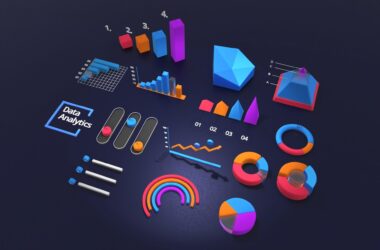Introduction:
In today’s fast-paced and highly competitive business landscape, organizations are continuously seeking ways to gain a competitive edge. One of the most potent tools at their disposal is data analytics and business intelligence (BI). Data analytics and BI enable companies to transform raw data into actionable insights, empowering decision-makers to make informed choices and drive strategic growth. This article explores the fundamental concepts of data analytics and BI, their significance in modern business, and how organizations can effectively leverage them to unlock their full potential.
Understanding Data Analytics:
Data analytics is the practice of examining vast amounts of data to uncover patterns, correlations, and trends. By employing various statistical and analytical techniques, organizations can extract valuable insights from data that would otherwise remain untapped. The data used in analytics can be collected from numerous sources, including customer interactions, sales transactions, social media, and operational systems.
Business Intelligence Defined:
Business Intelligence (BI) refers to the technologies, applications, and practices used to collect, integrate, analyze, and present data for informed decision-making. BI solutions often involve a combination of software tools, data warehouses, data visualization techniques, and reporting systems. The primary objective of BI is to transform raw data into meaningful and actionable information that can drive strategic planning, operational efficiency, and improved performance across all areas of an organization.
The Importance of Data Analytics and BI in Business:
In today’s data-driven world, businesses are increasingly recognizing the immense importance of data analytics and business intelligence (BI) in driving success and staying ahead of the competition. By leveraging the power of advanced analytics techniques and BI tools, organizations can transform raw data into valuable insights that inform strategic decision-making, optimize operations, and deliver exceptional customer experiences. From enabling data-driven decision-making to enhancing operational efficiency and gaining a competitive advantage, data analytics and BI have become indispensable tools for businesses seeking sustainable growth and innovation. In this section, we will delve deeper into the significant role that data analytics and BI play in modern business environments, highlighting the key benefits they bring and the opportunities they unlock.
- Data-driven decision-making: Data analytics and BI empower businesses to make informed decisions based on solid evidence rather than relying solely on intuition or gut feelings. By analyzing historical and real-time data, organizations can identify emerging trends, consumer behavior patterns, and market insights to drive business strategies.
- Improved operational efficiency: By implementing data analytics and BI tools, businesses can gain visibility into their operations, identify bottlenecks, and optimize processes. This can lead to streamlined workflows, reduced costs, and increased productivity.
- Enhanced customer experience: Understanding customer preferences, behavior, and buying patterns is crucial for businesses to deliver personalized experiences and targeted marketing campaigns. Data analytics and BI enable companies to segment their customer base, identify key customer segments, and tailor their offerings to meet specific needs.
- Competitive advantage: In today’s digital age, data has become a valuable asset. By leveraging data analytics and BI effectively, organizations can gain a competitive edge by identifying untapped market opportunities, predicting consumer demands, and outperforming their competitors.
Implementing Data Analytics and BI:
Implementing data analytics and business intelligence (BI) is a transformative process that empowers organizations to unlock the full potential of their data and gain valuable insights. However, embarking on this journey requires careful planning, strategic thinking, and the right tools and methodologies. In this section, we will explore the key steps involved in implementing data analytics and BI initiatives. From defining objectives and key metrics to gathering and integrating relevant data, selecting appropriate analytics tools, and analyzing and visualizing data, we will provide a comprehensive guide to help businesses navigate the complexities of implementing data analytics and BI successfully. By following these best practices, organizations can harness the power of data to drive informed decision-making, enhance operational efficiency, and propel their business towards sustainable growth.
- Define objectives and key metrics: Before embarking on a data analytics and BI journey, organizations must clearly define their goals, key performance indicators (KPIs), and metrics that align with their overall business strategy. This ensures that data analysis efforts are focused and meaningful.
- Gather and integrate relevant data: Identify the sources of data within the organization and consolidate them into a centralized data warehouse or data lake. This process involves extracting, transforming, and loading (ETL) the data, ensuring its quality, and maintaining data governance practices.
- Choose the right analytics tools: There are numerous data analytics and BI tools available in the market, each with its unique features and capabilities. Evaluate the requirements of your organization and select tools that best suit your needs. Popular options include Tableau, Power BI, QlikView, and Google Analytics.
- Analyze and visualize data: Once the data is organized and the tools are in place, the next step is to analyze the data and generate insights. Data scientists and analysts can use statistical models, machine learning algorithms, and data visualization techniques to uncover patterns, trends, and anomalies in the data. Visualizations, such as charts, graphs, and dashboards, help stakeholders understand complex information quickly.
- Enable self-service analytics: Empower business users across departments to access and analyze data independently through self-service analytics platforms. This reduces the dependency on data analysts and enables employees to make data-driven decisions in real-time.
- Monitor and iterate: Data analytics and BI are not one-time activities but continuous processes. Regularly monitor the performance of your analytics initiatives, identify areas for improvement, and iterate on your strategies to ensure ongoing success.
Conclusion:
Data analytics and business intelligence have revolutionized the way organizations operate, enabling them to harness the power of data for strategic decision-making and growth. By investing in the right tools, processes, and talent, businesses can unlock valuable insights, enhance operational efficiency, and gain a competitive advantage. Embracing a data-driven culture will be key to success in today’s dynamic business landscape, allowing companies to stay ahead of the curve and adapt to changing market conditions.
We would love to hear your thoughts and insights on the topic of data analytics and business intelligence. How do you perceive the significance of data analytics and BI in today’s business landscape? Have you witnessed or experienced the benefits they bring firsthand? Do you have any tips or challenges to share regarding the implementation of data analytics and BI initiatives? We invite you to share your opinions, experiences, and questions in the comment section below. Your input will contribute to a vibrant discussion and further enrich our understanding of this crucial topic.









